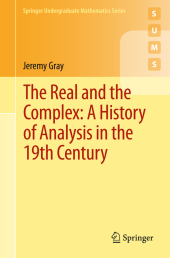 Neuerscheinungen 2015Stand: 2020-02-01 |
Schnellsuche
ISBN/Stichwort/Autor
|
Herderstraße 10
10625 Berlin
Tel.: 030 315 714 16
Fax 030 315 714 14
info@buchspektrum.de |

Jeremy Gray
The Real and the Complex: A History of Analysis in the 19th Century
1st ed. 2015. 2015. xvi, 350 S. 71 SW-Abb. 235 mm
Verlag/Jahr: SPRINGER, BERLIN; SPRINGER INTERNATIONAL PUBLISHING 2015
ISBN: 3-319-23714-4 (3319237144)
Neue ISBN: 978-3-319-23714-5 (9783319237145)
Preis und Lieferzeit: Bitte klicken
This book contains a history of real and complex analysis in the nineteenth century, from the work of Lagrange and Fourier to the origins of set theory and the modern foundations of analysis. It studies the works of many contributors including Gauss, Cauchy, Riemann, and Weierstrass.
This book is unique owing to the treatment of real and complex analysis as overlapping, inter-related subjects, in keeping with how they were seen at the time. It is suitable as a course in the history of mathematics for students who have studied an introductory course in analysis, and will enrich any course in undergraduate real or complex analysis.
Lagrange and foundations for the calculus.- Joseph Fourier.- Legendre.- Cauchy and continuity.- Cauchy: differentiation and integration.- Cauchy and complex functions to 1830.- Abel.- Jacobi.- Gauss.- Cauchy and complex function theory, 1830-1857.- Complex functions and elliptic integrals.- Revision.- Gauss, Green, and potential theory.- Dirichlet, potential theory, and Fourier series.- Riemann.- Riemann and complex function theory.- Riemann´s later complex function theory.- Responses to Riemann´s work.- Weierstrass.- Weierstrass´s foundational results.- Revision { and assessment.- Uniform Convergence.- Integration and trigonometric series.- The fundamental theorem of the calculus.- The construction of the real numbers.- Implicit functions.- Towards Lebesgue´s theory of integration.- Cantor, set theory, and foundations.- Topology.- Assessment.
"The Real and the Complex originated in a course Jeremy Gray gave to upper-level mathematics students and is part of a Springer series on undergraduate mathematics. An important aim of the book is to help the student understand how any given part of mathematics first arises and comes to fruition. ... for those readers with some university-level background in mathematics who are interested in the technical contours of nineteenth-century science, Gray´s book will repay careful study and is highly recommended." (Craig Fraser, Isis, Vol. 108 (2), June, 2017)
"I view it as an extremely valuable addition to my library and a book that I am sure I will consult frequently in the future: this is a text that should serve well as a desk reference for a faculty member teaching either analysis (real or complex) or the history of mathematics. Certainly, no good university library should be without it." (Mark Hunacek, MAA Reviews, maa.org, January, 2017)
"Gray´s 29 chapters take us on quite a ride through the ideas, results, and difficulties of the major figures of nineteenth-century analysis. ... Any mathematician who would like to know how analysis developed should find it interesting. Those who teach analysis can gain much insight from seeing the blind alleys as well as the great ideas ... . The writing style is clear and unpretentious, as well as marked by immense learning. ... I strongly recommend ... ." (Judith V. Grabiner, Notices of the AMS, Vol. 64 (11), 2017)
"The Real and the Complex ... develops the subject of analysis by reviewing the works of some of the prominent mathematicians of the 19th century. ... Summing Up: Recommended. Upper-division undergraduates, graduate students, researchers/faculty, professionals/practitioners." (M. D. Sanford, Choice, Vol. 53 (9), May, 2016)
"This is a history book on the development of mathematics in the 19th century. Each chapter is built up around one or a few mathematicians. ... this book is not only an interesting read for the students who (have to) study it, but equally valuable for professional mathematicians." (Adhemar Bultheel, European Mathematical Society, euro-math-soc.eu, February, 2016)


